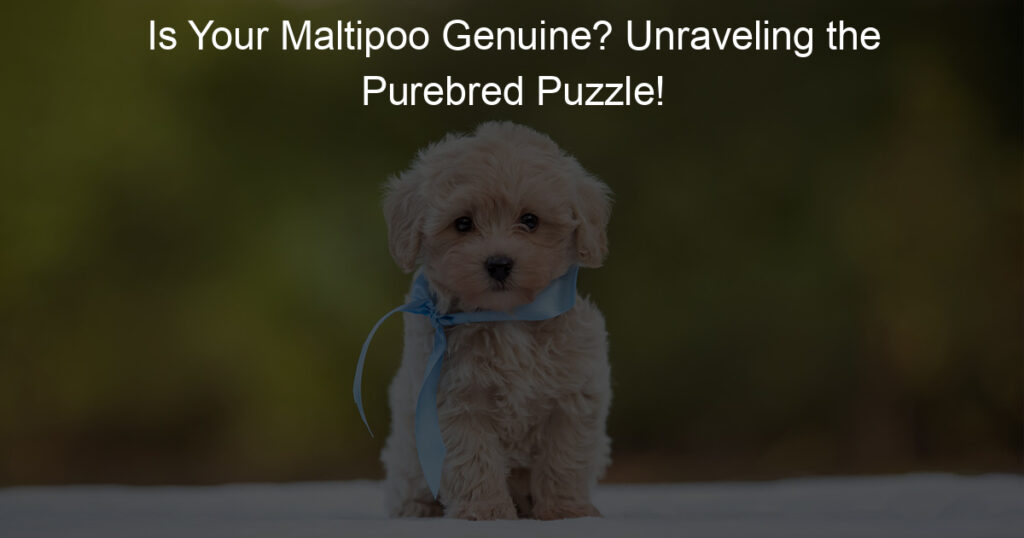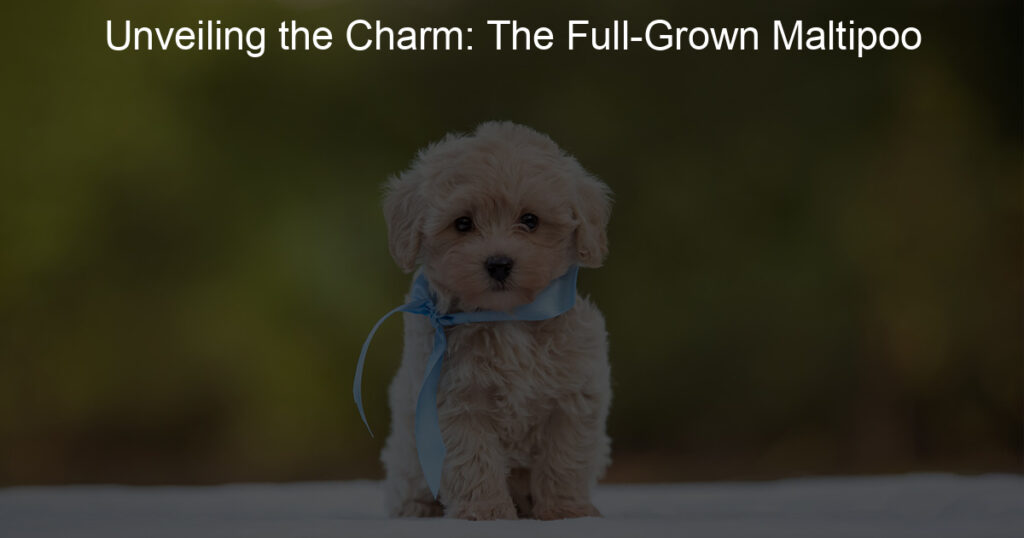
Introduction to Maltipoo Breed Characteristics
When it comes to finding the perfect furry friend, understanding breed characteristics is crucial. One breed that has been gaining popularity due to its unique features and charming personality is the Maltipoo. This breed is a mix between a Maltese and a Poodle, resulting in a dog that is both adorable and intelligent.
- Overview of Maltipoo breed
- Common traits and features of Maltipoos
The Maltipoo is a hybrid breed, a cross between a Maltese and a Miniature or Toy Poodle. This breed is known for its friendly disposition and high intelligence, making it a popular choice for families and individuals alike. Maltipoos are small dogs, typically weighing between 5 to 20 pounds and standing 8 to 14 inches tall. They have a lifespan of 10 to 15 years, which is relatively long for a dog of their size.
Maltipoos are known for their soft, fluffy coats, which can range from straight to slightly curly. Their coat colors can vary, but they are commonly white or cream. One of the most distinctive features of a Maltipoo is their expressive eyes, which are usually dark and round.
When it comes to personality, Maltipoos are known for their friendly and affectionate nature. They are great with children and other pets, making them a wonderful addition to any family. Maltipoos are also intelligent and easy to train. However, they can be a bit stubborn at times, so consistent, positive reinforcement training methods work best.
Health-wise, Maltipoos are generally healthy dogs, but they can be prone to certain conditions like hip dysplasia and White Shaker Syndrome. Regular vet check-ups and a balanced diet can help keep your Maltipoo healthy and happy.
In conclusion, the Maltipoo is a charming and intelligent breed that makes a great companion. Their friendly nature and adorable looks make them a popular choice among dog lovers. However, like any breed, they have their unique traits and potential health issues that prospective owners should be aware of.
Understanding the Purebred Maltipoo
When it comes to understanding the purebred Maltipoo, there are several factors to consider. These factors help distinguish a purebred Maltipoo from a mixed breed. Let’s delve into these factors.
What Makes a Maltipoo Purebred?
There are three main factors that determine whether a Maltipoo is purebred. These include genetic factors, physical characteristics, and behavioral traits. Let’s take a closer look at each of these factors.
- Genetic Factors
- Physical Characteristics
- Behavioral Traits
The genetic makeup of a Maltipoo is a crucial determinant of its purity. A purebred Maltipoo is a cross between a purebred Maltese and a purebred Poodle. Therefore, it should have 50% genes from each parent breed. DNA testing is a reliable method to confirm the genetic purity of a Maltipoo.
Physical characteristics are another way to identify a purebred Maltipoo. These dogs typically weigh between 5 to 20 pounds and stand 8 to 14 inches tall. They have a well-proportioned body with a rounded head, medium-length tail, and button-like eyes. Their coat is usually wavy or curly and comes in a variety of colors including white, black, apricot, and cream.
Behavioral traits are also indicative of a Maltipoo’s purity. Purebred Maltipoos are known for their friendly, affectionate, and intelligent nature. They are highly trainable and get along well with children and other pets. They are also known for their playful and energetic behavior.
Understanding these factors can help you identify a purebred Maltipoo. However, it’s important to remember that each Maltipoo is unique and may not perfectly fit these descriptions. Consulting with a reputable breeder or a professional can provide more accurate information about a Maltipoo’s purity.
Common Misconceptions about Purebred Maltipoos
When it comes to purebred Maltipoos, there are several misconceptions that often mislead potential dog owners. Let’s debunk two of the most common myths:
- Myth 1: All Maltipoos look the same
- Myth 2: Purebred Maltipoos are always healthy
Contrary to popular belief, not all Maltipoos look the same. While they share some common characteristics like their adorable teddy bear-like appearance, the physical traits of Maltipoos can vary. This is because they are a mix of two different breeds – Maltese and Poodles. Factors such as the size, color, and coat of the parent breeds can influence the appearance of a Maltipoo. So, while some may have more curly hair like a Poodle, others might have straighter hair like a Maltese.
Another common misconception is that purebred Maltipoos are always healthy. While it’s true that they often have fewer health issues than mixed breeds, they can still be prone to certain genetic disorders. Some of the common health issues that Maltipoos may face include hip dysplasia, epilepsy, and patellar luxation. Therefore, it’s essential to regularly check up on your Maltipoo’s health and ensure they are getting the right nutrition and exercise.
Understanding these misconceptions can help potential owners make informed decisions when considering a Maltipoo as a pet. Remember, every Maltipoo is unique and deserves love and care, regardless of their breed purity.
Identifying Purebred Dogs: Maltipoo Edition
When it comes to identifying a purebred Maltipoo, there are several physical features to look out for. These features are unique to the breed and can help you distinguish a genuine Maltipoo from a mixed breed.
Physical Features of a Real Maltipoo
Let’s delve into the specific physical features that define a purebred Maltipoo.
- Coat and color: A Maltipoo’s coat is one of its most distinctive features. This breed typically has a soft and fluffy coat that is either slightly wavy or curly. The color can vary widely, with the most common colors being white, black, brown, cream, and silver. However, a purebred Maltipoo will often have a coat that is a combination of these colors.
- Size and weight: Maltipoos are small dogs, typically weighing between 5 and 20 pounds. Their height can range from 8 to 14 inches at the shoulder. While there can be some variation in size, a dog significantly larger or smaller may not be a purebred Maltipoo.
- Facial features: Maltipoos have a distinctive face with round eyes that are either dark brown or black. Their ears hang down and are covered in soft, fluffy hair. The muzzle is usually medium in length, and the nose can be black or brown. A purebred Maltipoo will have these characteristic facial features.
Identifying a purebred Maltipoo can be a rewarding experience. By understanding and recognizing these physical features, you can ensure that you’re getting a genuine Maltipoo. Remember, while these features can help you identify a Maltipoo, the best way to confirm the breed is through a DNA test.
Behavioral Traits of a Genuine Maltipoo
When identifying a purebred Maltipoo, it’s not just about their physical features. Their behavior also plays a significant role. Let’s delve into the behavioral traits of a genuine Maltipoo.
- Temperament
- Activity Level
- Interaction with Humans and Other Animals
Maltipoos are known for their friendly and affectionate nature. They are often described as ‘people pleasers’ due to their eagerness to make their owners happy. This breed is also known for its intelligence and adaptability, making them easy to train. However, they can be a bit stubborn at times, so patience and consistency are key when training a Maltipoo.
Despite their small size, Maltipoos are quite active and energetic. They require regular exercise to keep them healthy and happy. A daily walk or a game of fetch in the backyard is usually enough to satisfy their exercise needs. However, they are also content with indoor activities and are known to be great companions for those living in apartments or houses with limited outdoor space.
Maltipoos are sociable creatures. They enjoy the company of humans and are known to get along well with children and other pets. Their friendly and gentle nature makes them excellent family pets. However, due to their small size, they can be easily injured by larger animals or rough play, so supervision is recommended when they are interacting with larger pets or young children.
In conclusion, a genuine Maltipoo is not only identifiable by its physical features but also by its distinctive behavioral traits. By understanding these traits, you can ensure that you are getting a purebred Maltipoo.
Maltipoo Authenticity: Beyond the Looks
While the adorable appearance of a Maltipoo can easily win hearts, it’s important to look beyond their cute exterior when determining their authenticity. One key factor to consider is their health.
Maltipoo Health: A Key to Authenticity
Just like humans, dogs also have health issues that are specific to their breed. Maltipoos are no exception. Understanding these health issues not only helps in providing better care for your Maltipoo but also plays a significant role in verifying their authenticity.
- Common health issues in Maltipoos
- Health screening for Maltipoos
Maltipoos are generally healthy dogs, but they can be prone to certain health conditions. These include patellar luxation (a knee condition), progressive retinal atrophy (an eye disorder), and epilepsy. They may also suffer from minor health issues like allergies and dental problems. Being aware of these common health issues can help you identify a genuine Maltipoo.
Health screening is an essential part of ensuring your Maltipoo’s well-being and authenticity. A reputable breeder will provide health clearances for both of the Maltipoo’s parents, which prove that they have been tested and cleared for specific health conditions. These clearances are your assurance that the breeder has made a conscious effort to produce healthy puppies.
In conclusion, while the charming looks of a Maltipoo can be captivating, it’s crucial to delve deeper into aspects like health to ensure you’re getting an authentic Maltipoo. Remember, a healthy Maltipoo is a happy Maltipoo!
Importance of Pedigree in Maltipoo Breed Verification
When it comes to verifying the breed of a Maltipoo, the pedigree plays a crucial role. But what exactly is a pedigree, and how can it be used in breed verification? Let’s delve into this topic.
- Understanding Dog Pedigrees
A pedigree is a family tree for dogs. It provides information about a dog’s ancestors, tracing back several generations. This document is essential in confirming the purebred status of a dog. Pedigrees can reveal patterns of inheritance for specific traits, including health conditions and physical characteristics. Understanding a pedigree can give you insights into your Maltipoo’s lineage and potential health risks.
| Term | Definition |
|---|---|
| Sire | The father of a dog |
| Dam | The mother of a dog |
| Progeny | The offspring of a dog |
- How to Verify a Maltipoo’s Pedigree
Verifying a Maltipoo’s pedigree involves checking the authenticity of the pedigree document and ensuring that the information aligns with the dog’s characteristics. The pedigree should trace back to purebred Maltese and Poodle ancestors. If the pedigree shows any other breeds in the lineage, the dog is not a purebred Maltipoo.
It’s important to obtain the pedigree from a reputable source. Reputable breeders or breed clubs typically provide pedigrees. You can also request a pedigree from the breeder and verify it through a recognized kennel club or breed registry.
Remember, a genuine pedigree is more than just a piece of paper. It’s a testament to your Maltipoo’s lineage and a tool for understanding your dog’s health and characteristics better.
Recognizing Purebred Maltipoo: Case Studies
Understanding the characteristics of a purebred Maltipoo can be challenging. Here, we explore a real-life case study to help you identify a purebred Maltipoo.
Case Study 1: Identifying a Purebred Maltipoo
Let’s delve into the details of a case where the identification of a purebred Maltipoo was successfully carried out.
- Background of the case: The case involved a Maltipoo named Bella, bought from a reputed breeder. The owner had doubts about Bella’s authenticity as a purebred Maltipoo due to her unusual size and coat texture.
- Process of identification: Bella was taken to a professional dog geneticist. The geneticist carried out a DNA test, which is the most reliable method to determine a dog’s breed. The test involved taking a swab from Bella’s cheek for DNA extraction.
- Outcome and key takeaways: The DNA test confirmed that Bella was indeed a purebred Maltipoo. This case highlights the importance of DNA testing in confirming a dog’s breed. It also emphasizes that physical characteristics like size and coat texture can sometimes be misleading when identifying a purebred Maltipoo.
In conclusion, identifying a purebred Maltipoo can be a complex process. However, with the right knowledge and tools, it is entirely possible. Remember, a dog’s physical appearance can sometimes be deceptive, and DNA testing is the most reliable method for breed identification.
Case Study 2: The Maltipoo That Wasn’t
- Background of the case:
Meet Bella, a fluffy, playful dog that was believed to be a purebred Maltipoo. Bella’s owner, Mrs. Johnson, purchased Bella from a local pet store. The store owner assured Mrs. Johnson that Bella was a purebred Maltipoo. However, as Bella grew older, Mrs. Johnson started noticing some unusual traits that didn’t align with the typical characteristics of a Maltipoo.
- Signs that indicated the dog wasn’t a purebred Maltipoo:
Bella’s size was the first sign that raised a question. Maltipoos are known to be small dogs, typically weighing between 5 to 20 pounds. However, Bella weighed 30 pounds, which is quite unusual for a Maltipoo. Furthermore, Bella’s coat was not as curly as a typical Maltipoo’s. Instead, it was straight and long. Bella also lacked the hypoallergenic qualities common in Maltipoos, causing Mrs. Johnson to have allergic reactions.
- Outcome and key takeaways:
After consulting with a professional dog breeder and conducting a DNA test, it was confirmed that Bella was not a purebred Maltipoo. She was, in fact, a mix of a Maltese and a Shih Tzu. Although Mrs. Johnson was initially disappointed, she realized that the breed didn’t matter. She loved Bella regardless. The key takeaway from this case is the importance of purchasing pets from reputable breeders and verifying their claims. It’s also crucial to remember that a dog’s breed doesn’t determine its value or the love it can offer.
Conclusion: Solving the Purebred Dog Puzzles
In this article, we’ve embarked on a journey to understand the world of purebred Maltipoos. We’ve explored their unique characteristics, the importance of their authenticity, and how to recognize a purebred Maltipoo. Let’s recap what we’ve learned.
- Recap of Maltipoo breed characteristics
- Importance of knowing your Maltipoo’s authenticity
- Final thoughts on recognizing a purebred Maltipoo
The Maltipoo is a delightful blend of the Maltese and Poodle breeds, known for its friendly nature and hypoallergenic coat. These dogs are small, usually weighing between 5 to 20 pounds, and have a lifespan of 10 to 15 years. They are intelligent, easy to train, and make excellent companions.
Knowing your Maltipoo’s authenticity is crucial for several reasons. It helps ensure that you’re getting a healthy dog, as purebred dogs are bred to maintain specific health standards. It also guarantees that your Maltipoo will grow to have the characteristics you expect of the breed. Lastly, it protects against unethical breeding practices.
Recognizing a purebred Maltipoo can be a challenge, but with the right knowledge, it’s entirely possible. Look for physical characteristics like size, coat type, and color. Also, consider the dog’s temperament and health history. Remember, a reputable breeder will always provide documentation of a dog’s lineage.
In conclusion, understanding the Maltipoo breed and being able to identify a purebred Maltipoo can enhance your experience as a pet owner. It allows you to make informed decisions about your pet’s health and well-being, and ensures that you’re supporting ethical breeding practices. So, keep these insights in mind as you navigate the world of purebred Maltipoos.








